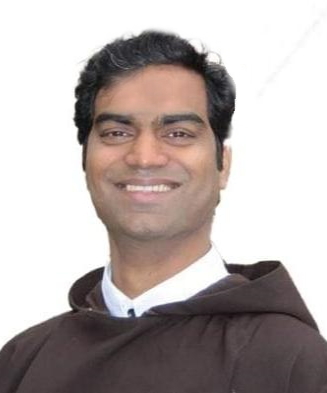Peter’s Mentor: The Beloved Disciple
(Jn 21:1-19)
In the liturgy, since the beginning of the Easter Triduum (the three days before Easter), through the Eastertide we hear so much from the Gospel of John. In the passion narrative and in the resurrection accounts of the Gospel of John, suddenly we have a new disciple who is introduced as: “the one whom Jesus loved” (Jn 13:23; 19:26; 20:2; 21:7, 20). He is unique to the Gospel of John, and he is unnamed. Being anonymous there is something mysterious about him; there is something mythical about him; and in fact, there is something divine about him.
Interpreting this figure within the general style of the Gospel of John – that this Gospel is highly symbolic – I have always looked at this ‘Beloved Disciple’ as a symbolic person. In this way, I find it possible to identify myself with that disciple, and to seek the intimacy granted to him by Jesus.
However, what surprised me, as I kept looking at this Beloved Disciple during the Holy Week and particularly during the Easter Octave one year, was a new insight that came to me about this disciple. And that is what I want to share with you today. Without getting into the debates of the Biblical scholars about who is this BD, what we want to do is to look at the BD and see what he meant for Peter; and in so doing, we can ask ourselves: what does the BD mean for me today? What does the BD challenge me to, here and now? What is Jesus challenging me to, through the BD?
The Beloved Disciple as the Mentor of Peter
This was the insight: I notice that whenever ‘the disciple whom Jesus loved’ is referred to in the Gospel, Peter is also mentioned; and often the reaction of the Beloved Disciple is contrasted with that of Peter.
We hear of the Beloved Disciple, for the first time, during the last supper (Jn 13:23). We find him “reclining next to Jesus” (NJB). On this occasion the Beloved Disciple becomes the spokesperson for Peter. Was it because the BD was next to Jesus that when Jesus spoke of the one who was going to betray him, “Peter signed to him and said, ‘Ask who it is he means’? Or, was it because Peter was afraid to ask the question himself? Jesus, perhaps, was quick to pick this up about Peter, even as he was talking about Judas. And later Jesus would confront the cowardice of Peter (13:37-38). So during the course of the meal, when Peter said, ‘I will lay down my life for you.’ Jesus said to him, ‘In all truth I tell you, Peter, before the cock crows you will have disowned me three times.’
So a question that I ask myself is: in my faith journey who am I hiding behind? Am I pretending to be serious about my relationship with Jesus, while actually I am not too sure of myself? Therefore, do I hide behind the faith of someone else, and depend on the prayers of others? There is nothing wrong with this. But do I also hear Jesus challenging me to something more?
The second time that we come across the disciple whom Jesus loved is at the foot of the cross. In the build up to this, John 18 talks about what was happening to Peter while the trial of Jesus was in progress. Peter is together with ‘another disciple’ (Jn 18:15) – some commentators say, it is the BD. Actually Peter is avoiding his company. But the other disciple comes out to take him into the palace of the high priest. Apparently at this point they part company. As Bishop Fulton Sheen, the famous American TV evangelist, says, while the other disciple wants to be close to Jesus in his trials, Peter seeks “creaturely comfort” near the fire. And this was his downfall. Peter denies Jesus. So, we can assume that as the BD stands at the foot of the cross (Jn 19:26-27), representing the whole body of disciples, Peter himself is out of the scene, perhaps overcome by remorse for his fall.
The BD then catches up with Peter on the Easter morning (as we heard read in the gospel reading of the liturgy of the Easter morning – Jn 20:1-8). In fact, it is Peter who is trying to catch up with the BD, at least in their run up to the empty tomb. Both see the signs of the resurrection: “the linen cloths lying on the ground, and also the cloth that had been over his head”. Peter just saw. On the other hand, the BD, saw and he believed” (Jn 20:8). Did the BD find it easy to believe because he was close to Jesus at the last supper? Did he find it easy to believe because he was close to Jesus at the foot of the cross? As for Peter, his encounter with the Risen Lord is slow to come by.
Finally, we have it. The passage that we heard read as the gospel text of this Sunday.
Peter has his moment as the Beloved Disciple disappears to the background.
The setting is the Lake of Tiberias (just another name for the Sea of Galilee). Eight days have gone by since the resurrection. Seven of the apostles are there, and the BD is not precisely mentioned in the list. He will suddenly make his appearance later in the story. But why was the band of the disciples in Galilee moving away from Jerusalem, the epicentre of the events of the past week? In Mk 16:7, the women who went to the empty tomb were given a message by ‘the young man’ (the angel!): “you must go and tell his disciples and Peter, “He is going ahead of you to Galilee; that is where you will see him….” Is it because of this message that they were in Galilee? Or, was it something else? The story in today’s gospel begins with the statement from Peter, “I’m going fishing” (Jn 21:3), and the others say, “We’ll come with you.” This is backsliding. Peter is going back to his old profession, and he is misleading the rest of the band. But their work is futile. And it was night.
Then Jesus appears. It is light by now. The presence of Jesus brings success to the work of their hands. Remember what he had said during the final discourse: “cut off from me you can do nothing” (Jn 15:5). And suddenly the BD appears from nowhere and alerts Peter to the presence of Jesus, “It is the Lord” (Jn 21:7). Here, the BD acts as the inner voice of Peter.
There has been a great catch of fish (similar to Lk 5:1-9), there is the awareness of the uniqueness of Jesus as the Lord (similar to the experience at Caesarea Philippi, Mt 16:13-19), and there is a meal made ready (an experience of the Eucharist), there is going to be that unique encounter between Jesus and Peter in the Gospel of John. The encounter is in terms of a personal love for Jesus: “Simon son of John, do you love me more than these others do? Simon son of John, do you love me? Simon son of John, do you love me?” Three times! Perhaps to remind Peter of the threefold denial. ‘Simon son of John’: it is a formal ultimatum. It is also a moment of empowering: “Feed my lambs. Look after my sheep. Feed my sheep.” It is a moment of assurance that, despite one’s inabilities, despite one’s failures, despite one’s past, what finally counts is, love!
If you continue to read on, you will notice in the next scene (Jn 21:20-23): it is Peter who is close to the Lord, and the disciple whom Jesus loved is trailing behind. Peter now becomes the spokesperson for the BD. The BD can now disappear into the background, because his task is complete.
Conclusion – Questions to reflect on:
· What are the moments in my life when I have felt weak like Peter? Who was the Beloved Disciple, at those moments who helped me recognize Jesus and to respond to his love?
· Is there somebody in my life at this moment, who perhaps needs the assistance of a Beloved Disciple, so as to recognize the Lord? Am I willing to be the BD for them?
Fr. Franco Pereira, S.D.B.


